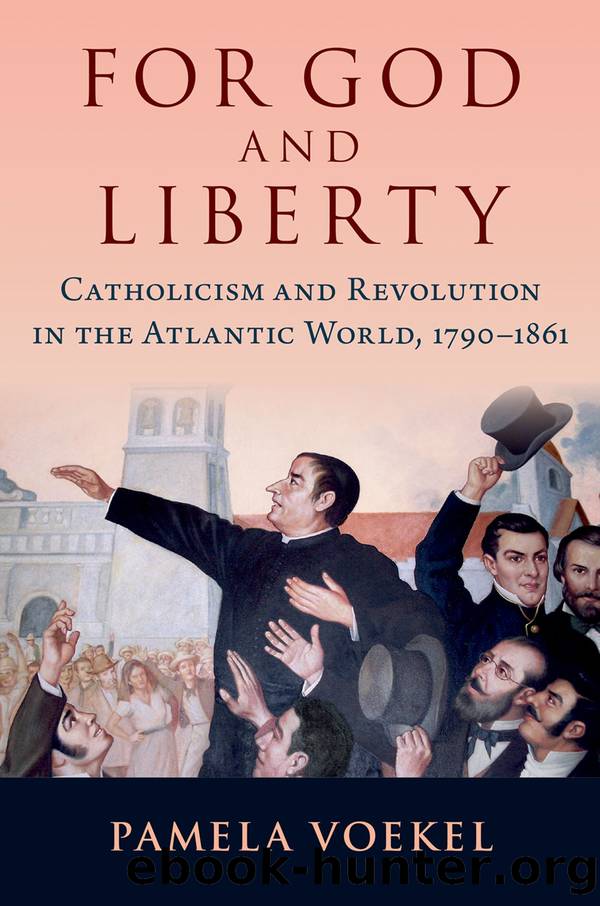For God and Liberty by Pamela Voekel

Author:Pamela Voekel
Language: eng
Format: epub, pdf
Publisher: Oxford University Press
Published: 2022-06-15T00:00:00+00:00
8
The Long Shadow
Mexicoâs Reforma
The combatants had withdrawn from the literal field of battle in Central America by the middle decades of the nineteenth century, but the fundamental conflicts over theology and ecclesiology could still bring the opposing sides to arms. Mexicoâs signal moment of constitutional conflict, the War of the Reform that rent the country from 1857 to 1860, was animated by many of the same concerns.1 The divisions remained salient in that warâs continuation, the French imperial intervention of 1861 to 1867, when the ultramontane church actively supported the foreign empire.
For more than forty years, the homeland of Fray Servando Teresa de Mier had been both denounced and championed throughout the Atlantic World as a critical breeding ground of the Reform Catholic International. The explosively dangerous cache of literature that had landed this father of Mexican independence in chains back in 1817 was, above all else, a portable library of Reform Catholic literature and of national constitutions and federalist writings. Mier would have recognized Mexicoâs 1857 Constitution as the heir of this sacred intelligence. So did many of the constitutionâs own champions at the time.
Their interpretation has been underrepresented in subsequent historical literatures. Instead, historians of Latin Americaâs mid-nineteenth-century liberals have concluded that the movementâs program of church-state separation amounted to an unambiguous secularization drive.2 Certainly the means suggest this end: between their initial success in the 1850s and their subsequent displacement by conservative forces allied with the French invaders, the liberals placed birth, death, and marriage rites under state auspices; ended the churchâs special privileges and prerogatives; and removed religious expression from the streets and corralled it into the home or the church building.
But a closer look at the actorsâ own paper trail suggests a radically different interpretation of their motives. Far from seeking to remove religion from Mexican national life, they were instead consumed with refashioning the Catholic Church from within, with paring down its hierarchy and simplifying its liturgy without eliminating its central mysteries. In place of Romish excess they envisioned not a secular society but a Godly alternative.
As we have seen, Reform Catholicism as far back as the early eighteenth century had advocated for civil control over the church, not out of animosity to religion but in order to create more godly empires and states. Central American reformers had imbibed this wisdom from such reformist luminaries as Pietro Tamburini and the Synod of PistoÃa, who had described and circulated the civil powerâs long historical genealogy of rightful dominance of the church.3 Mexicoâs liberals formed a central node in the mid-century Reform Catholic International. They were anything but secular, and, like El Salvadorâs reformist Catholic liberals we saw earlier, exhibited as much if not more religious passion than did the conservative forces they battled during Mexicoâs War of the Reform.4
The centrality of Reform Catholicism to Mexican liberalism of the mid-century is brought into high relief by the 1859 establishment of a schismatic Catholic Church under state protectionâthe opposite of state-driven secularization. Prominent liberals cast their newly
Download
This site does not store any files on its server. We only index and link to content provided by other sites. Please contact the content providers to delete copyright contents if any and email us, we'll remove relevant links or contents immediately.
| Africa | Americas |
| Arctic & Antarctica | Asia |
| Australia & Oceania | Europe |
| Middle East | Russia |
| United States | World |
| Ancient Civilizations | Military |
| Historical Study & Educational Resources |
Cecilia; Or, Memoirs of an Heiress — Volume 1 by Fanny Burney(32491)
Cecilia; Or, Memoirs of an Heiress — Volume 2 by Fanny Burney(31909)
Cecilia; Or, Memoirs of an Heiress — Volume 3 by Fanny Burney(31887)
The Secret History by Donna Tartt(18936)
Sapiens: A Brief History of Humankind by Yuval Noah Harari(14311)
Leonardo da Vinci by Walter Isaacson(13231)
The Radium Girls by Kate Moore(11965)
Sapiens by Yuval Noah Harari(5321)
How Democracies Die by Steven Levitsky & Daniel Ziblatt(5168)
The Wind in My Hair by Masih Alinejad(5055)
Homo Deus: A Brief History of Tomorrow by Yuval Noah Harari(4870)
Endurance: Shackleton's Incredible Voyage by Alfred Lansing(4715)
Man's Search for Meaning by Viktor Frankl(4495)
The Silk Roads by Peter Frankopan(4487)
Millionaire: The Philanderer, Gambler, and Duelist Who Invented Modern Finance by Janet Gleeson(4417)
The Rape of Nanking by Iris Chang(4165)
Joan of Arc by Mary Gordon(4051)
The Motorcycle Diaries by Ernesto Che Guevara(4046)
Hitler in Los Angeles by Steven J. Ross(3922)
